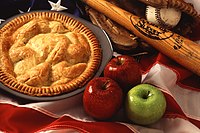
Photo from wikipedia
A test using a solid food is relevant to measure chewing ability (CA) as (1) it includes an integrated functioning of all oral structures involved, (2) an impairment of chewing… Click to show full abstract
A test using a solid food is relevant to measure chewing ability (CA) as (1) it includes an integrated functioning of all oral structures involved, (2) an impairment of chewing a solid food causes inevitably diet restrictions, and (3) chewing efficiency (CE) can easily be defined. CE is the number of chewing cycles, N[1/2-Xo], needed to attain a particular chewing outcome (a median particle size, X50 , which is half the initial particle size Xo) whereas chewing performance (CP) is a state of chewing outcome (X50 ) at an arbitrary number of chewing cycles. The use of CE is preferable for CA because inter-subject ratios are constant regardless of the initial conditions of the test food. Furthermore, the inter-subject variation is two times larger for CE values than for CP ones, yielding a better inter-subject differentiation of CA. However, a determination of CP needs only one N-value, and that of CE at least two N-values for enabling an interpolation of N[1/2-Xo]. Using samples of only 2 half-cubes (9.6x9.6x4.8 mm; limiting test load) of Optosil® (an artificial test food), and detailed previous information on log(X50 )-log[N] relationships (Liu et al., 2018) as a "gold standard", a short procedure has been developed for a priori choosing two appropriate N-numbers, and the subsequent determination of a subject's CE. This procedure has been developed using results from 20 young adults (23.7 years, SD 1.1) and was validated in 10 middle-aged and older adults (52.3 years, SD 10.1), where impairments in the dentition were reflected in the CE-values. Our short procedure to determine chewing efficiency will improve studies on relationships between chewing ability and food preference, or between chewing ability and dental factors and/or physiological factors. The first type of relationship may be of interest for food industry whereas the second type may be of interest for population studies in rapidly aging societies and for clinical studies in dentistry. Results can be compared between subjects and studies without bias by using chewing efficiency rather than chewing performance as a measure of chewing ability. This article is protected by copyright. All rights reserved.
Journal Title: Journal of texture studies
Year Published: 2019
Link to full text (if available)
Share on Social Media: Sign Up to like & get
recommendations!